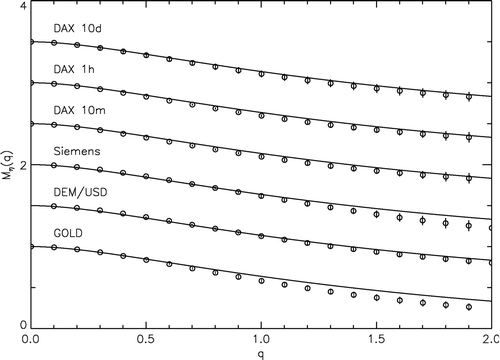Abstract
We propose a nonparametric method to determine the functional form of the noise density in discrete-time stochastic volatility models of financial returns. Our approach suggests that the assumption of Gaussian noise is often adequate, but we do observe deviations from Gaussian noise for some assets, for instance gold.
Acknowledgements
We are grateful to Thomas Lux for providing us with his cleaned set of high-frequency DAX data, and to Vasyl Golosnoy for useful comments.
Notes
1Notice that this assumption is violated by GARCH models.
2Instead of extrapolating, we also performed the analysis for the first lag, τ = 1, and averages of early lags, obtaining very similar results in each case.
3Since we are mostly interested in a qualitative impression of the involved magnitudes, we checked that the autocorrelation of Mi (q) does not show any systematic deviation from zero, justifying Assumption 3 at least in a first approximation.
4Choosing B = 9,10,11 yields very similar values for the error bars.
5The theoretical value of M(2) in GARCH(1,1) turns out to be larger than the empirical value. Thus, our findings would in a sense corroborate the results of Bollerslev (Citation1987), who finds that a GARCH(1,1) model often provides a better fit if the noise term is student-t rather than normally distributed.
Fig. 2. Moment ratio under the assumption of Gaussian noise, M
η(q), compared to the actual moment ratio computed from various asset returns, . For better visibility, data and curves are shifted by 0.5 each time. The error bars correspond to 95% confidence intervals. The series show, from top to bottom, the moment ratio for the DAX at 10-day, hourly and 10-min frequencies. Returns to Siemens shares, the DEM/USD exchange rate and gold are all measured at daily frequencies
